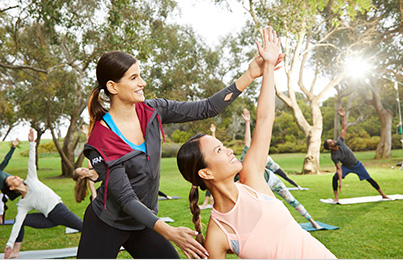
Relevant teaching and instruction techniques, styles and methods are considered in planning the session or class and effectively utilised when implemented.
When teaching a group class, there are a number of approaches an instructor can take in order to get the message across effectively to the participants.
The instructor can use either a ‘part’ approach, in which case the skill is broken down into its component parts and each part is practiced. When using the “whole” approach, the skill is practiced in its entirety.
Task complexity refers to the number of parts or components within a task, and the level of information processing required to complete the task. A highly complex task has many components and requires more attention. Aerobic combinations with intricate footwork and arm movements can be highly complex.
Low complexity tasks have few components and relatively limited attention demands.
Teaching styles and how and when to utilise a teaching style given the needs and aims of the exercise to music participant/s
The teaching style chosen is an important factor in determining the success of the class. The different styles are listed below:
Command Style
An instructor using this style makes all the decisions about posture, rhythm and duration, while participants follow his or her directions and movements. The command style is one of the more efficient teaching styles, and is clearly the style that best introduces a subject.
A problem arises, however, if the instructor does not extend beyond the command style during a lesson. This style means that the learner does not need to make any decisions during the session.
Practice Style
The practice style provides a means for the instructor to individualise the training session. A key part of practice style teaching is that it allows the participant time to practise and obtain instructor feedback. Participants can work at their own pace and rhythm.
Reciprocal Style
The reciprocal style involves the use of an observer to provide feedback to participants. “The major difference between command and reciprocal teaching is that the students assume more responsibility for observing the performance of their peers and providing feedback on each attempt.” (Mosston & Ashworth, 1986)
When using either of the above styles of teaching, exercise performance is evaluated and discussed for modification or improvement performance.
Self-Check Style
The self-check style relies on participants to provide their own feedback. Participants perform a given task and then record the results and compare their performance against given criteria or past performances.
Before demonstrating an exercise/taking a session, the instructor is to develop a matrix from which to assess performance. Once the task has been completed, the instructor will assess performance against the criteria set.
Inclusion Style
The inclusion style is particularly relevant to the group fitness setting, where participants may have different fitness levels. The instructor is able to teach multiple levels of performance within the same activity e.g. fitter participants may be taught more advanced exercises during a class.
Once you know what areas to work on, it is advisable to practise, and practise some more!
Feedback
Once the instructor has assessed performance of members of a class, he/she will need to provide feedback on the performance.
Feedback can be used to:
• Provide reinforcement of what was well done
• Correct errors
• Motivate clients to do better
Three types of knowledge of results may be used when giving knowledge of results:
• Corrective statements where the error is identified and the participant is told how to correct it
• Value statements: For example, “you have done well!” is a good means of providing motivation
• Neutral statement: This involves, for example, acknowledgement of completion of a task
The Learning Processes and Stages of Learning, as it Applies to Physical Activity
From a young age, you will have adopted a process of learning new skills. When you think about it, when it comes to practicing skills which you may have done before, the process is quite different to when attempting a skill for the first time. In a model developed by Fitts and Posner, the process is broken up into three stages:
Cognitive Phase
When a learner is new to a specific task, the primary thought process starts with, “what needs to be done?” Considerable cognitive activity is required so that the learner can determine appropriate strategies to adequately reflect the desired goal. Good strategies are retained and inefficient strategies are discarded. The performance is greatly improved in a short amount of time. In this stage of learning the movements are often uncoordinated and jerky. The fitness instructor should use the “tell, show, do” teaching technique, and provide ample opportunity for practise. It is important that the instructor does not give the participant too many skills during this phase.
Associative Phase
The learner has determined the most effective way to do the task and starts to make subtle adjustments in performance. Improvements are more gradual and movements become more consistent. This phase can last for a long time. The skills in this phase are fluent, efficient and aesthetically pleasing. In this phase the instructor can do less teaching and more monitoring.
Autonomous Phase
This phase may take a long period of time to reach. In this phase the instructor can complete the task without having to pay any attention to thinking about it too much. Examples include walking and talking. In this phase the instructor can do less teaching and more monitoring. Once the skill has been mastered, the personal trainer may add new skills, which are more advanced. The aim of instructors working with athletes would therefore be to teach good technique, whereby the athlete is eventually at the autonomous stage i.e. performing that skill with good technique naturally.
